- News
- Reviews
- Bikes
- Components
- Bar tape & grips
- Bottom brackets
- Brake & gear cables
- Brake & STI levers
- Brake pads & spares
- Brakes
- Cassettes & freewheels
- Chains
- Chainsets & chainrings
- Derailleurs - front
- Derailleurs - rear
- Forks
- Gear levers & shifters
- Groupsets
- Handlebars & extensions
- Headsets
- Hubs
- Inner tubes
- Pedals
- Quick releases & skewers
- Saddles
- Seatposts
- Stems
- Wheels
- Tyres
- Tubeless valves
- Accessories
- Accessories - misc
- Computer mounts
- Bags
- Bar ends
- Bike bags & cases
- Bottle cages
- Bottles
- Cameras
- Car racks
- Child seats
- Computers
- Glasses
- GPS units
- Helmets
- Lights - front
- Lights - rear
- Lights - sets
- Locks
- Mirrors
- Mudguards
- Racks
- Pumps & CO2 inflators
- Puncture kits
- Reflectives
- Smart watches
- Stands and racks
- Trailers
- Clothing
- Health, fitness and nutrition
- Tools and workshop
- Miscellaneous
- Buyers Guides
- Features
- Forum
- Recommends
- Podcast
feature
2011 WorldTour bikes: In full - Which teams are riding what bikes & kit this season
Although the early-season Classics are still a few weeks away, the WorldTour (ProTour as was) teams have already raced the first event, the Tour Down Under, so it’s high time we took a look at the bikes they’re all riding this year.
There are 18 WorldTour teams, most of them on the same bike brands as last year, but there are a few notable exceptions. Garmin have joined up with Cervélo, for instance, and HTC Highroad (who were HTC Columbia) have switched from Scott to Specialized. That makes three teams on Specialized now – HTC Highroad, Saxo Bank Sungard, and Astana.
The only other bike brands with more than one team are Trek (Leopard Trek, Radioshack) and Pinarello (Sky and Movistar). Scott aren’t represented.
On the groupset front, it’s the newest of the three big players that leads the way. SRAM supply eight teams, Shimano six and Campagnolo four, down from six last year (maybe that's why they haven't got round to updating their sponsored team list… too painful; mind you, neither have SRAM… too busy?). Of Campag's four teams, Team Movistar are trialling their electronic shift system. Shimano lead the way on wheels, though, with four teams on their rolling stock, Mavic following with one fewer.
Anyway, that’s enough stats. Feast your eyes on this little lot…

Ag2r-La Mondiale
Kuota, SRAM, Reynolds
France’s Ag2r-La Mondiale, home to Ireland’s Nicholas Roche, will be riding Kuotas again in 2011. They’re on KOM road bikes – unidirectional high modulus carbon fibre with BB30 bottom brackets. The head tube tapers from 1 1/8in to 1 1/2in this year. Last year it was 1 1/4in down below – they’ve increased the diameter a touch for a bit more stiffness.
Ag2r are one of eight ProTour teams running SRAM Red groupsets with some of the top guys getting their power measured with SRM PowerMeters. The wheels come from Reynolds – Thirty-twos and Forty-sixes, in the main (the numbers referring to the rim depth, in millimeters). Both models are high modulus carbon fibre, and they both get Reynolds’ Swirl Lip Generator for 2011 – shaping on the inner edge of the rim that’s designed to help the separated air ‘reattach’, reducing the pressure drag say Reynolds. The shape is also intended to minimise the side forces acting on the wheel in a crosswind.
Deda provide the cockpit components, the saddles are from San Marco and the pedals are Times.
For the time trials, Ag2r riders switch to the Kuota Kalibur which comes with aero everything – tube shaping, seat post, forks – and a diddy head tube (12.5cm on the 56cm frame) for an aggressive, low profile ride position. Like pretty much every high-end TT bike these days, the seat tube is moulded around the shape of the rear wheel with no gap to the brake bridge on the seatstays.
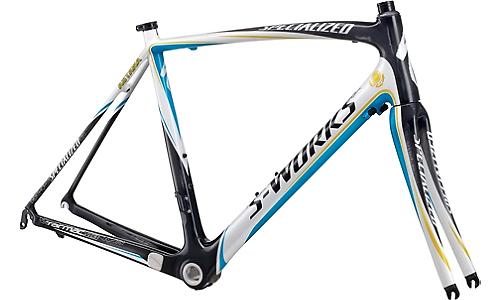
Astana Cycling Team
Specialized, SRAM, Corima
Things have never been settled at Astana, what with team leader Alexandre Vinokourov getting banned, Lance Armstrong coming in and racing team-mate Alberto Contador, Vino coming back, Armstrong leaving, Johan Bruyneel leaving, Contador leaving… A bit of a mess, really.
What’ll happen in 2011 is anyone’s guess but Vino is still there plugging away. Like Team Saxo Bank Sungard and HTC-Highroad, Astana are on Specialized Tarmac SL3s with the Shivs brought out when it’s time to race contre la montre (it just sounds better than ‘against the clock’). That’s a whole lot of Specializeds on the pro circuit.
Astana share a groupset supplier with Saxo Bank too, going with SRAM, while the wheels come from Corima who take over from Zipp. Corima don’t have the biggest presence in the UK market but the French brand were one of the first to launch carbon wheels. Judging from the recent Tour Down Under, the Astana boys will spend most of their time on the 45mm-deep Aero+ model.
Selle Italia provide the perches – mostly Flites, judging again by the Tour Down Under – the carbon cockpits come from FSA, and the pedals are Look Kéo Blades.
BMC Racing Team
BMC, Shimano, Easton
BMC are a US team although BMC bikes are based in Switzerland and the best-known rider on the squad is Australian Cadel Evans.
The main bike the riders race on is the BMC Impec, which has been introduced into the product line for the first time in 2011. The Impec is robot-built from carbon tubes that are manufactured on-site. Instead of placing carbon sheets in moulds by hand, BMC weave carbon fibres into seamless tubes which allows them, they say, to control the form and load-bearing properties of every tube to the maximum extent. The tubes slot into injection-moulded composite joints, a process BMC call their Shell Node Concept. Just don’t call those joints lugs – BMC will get arsey.

They also have the option of riding on board the Team Machine SLR01 which, BMC say, “Achieves the seemingly impossible: maximum stiffness with the greatest possible comfort. The Tuned Compliance Concept applied to the chainstays, seatstays and fork blades provides vertical flexibility and thus a tangibly more comfortable ride. Meanwhile, a stable bottom bracket hub and steering head area guarantee propulsion without compromise and incredibly precise handling. Low-vibration brake fundamentals enable quick and controlled braking and ensure safety in all riding conditions.”

So now you know. The team race against the clock on board the ultra-slim BMC Time Machine TT01 which comes with a top tube that slopes slightly upwards, and a hinge instead of a standard head tube.
On the component front, BMC Racing have switched from Campag to Shimano Di2 for 2011. Easton still provide the wheels, though, EC90 SLs and Aeros being used in the Tour Down Under. Fizik, Speedplay and Conti make up the rest of the kit.
Euskaltel-Euskadi
Orbea, Shimano
You can’t miss the Euskaltel-Euskadi team in the peloton; they’re the ones in the bright orange jerseys. All the riders are from the Basque region of northern Spain and southern France, with Olympic gold medalist Samuel Sanchez being the team leader.
The Euskaltel boys ride Orbeas, naturally enough, Orbea being based in Mallabia in the Basque region. The main model they use is the Orca, one of the fastest race bikes we’ve ever ridden. It’s a high modulus carbon monocoque that’s been developed with wind-tunnel technology to improve the aerodynamics. The seatstays, chainstays and fork legs, for example, run close to the wheels to keep the frontal area low before kinking out at the last second to accommodate the hubs. The seat tube has a wind-cheating profile too, with a cutout for the rear wheel.
Orbea use a BB30 bottom bracket to allow more stiffness to be engineered into the frame, and they vary the orientation of the carbon according to the frame size to fine-tune the performance according to the size of the rider on board. The idea is that all the Orcas ride the same, whether you’re on a 48cm or a 60cm model.
Euskaltel are powered by Shimano groupsets and the wheels are Dura-Ace too. They ride on Selle Italia saddles, FSA bars and Vittoria tyres.
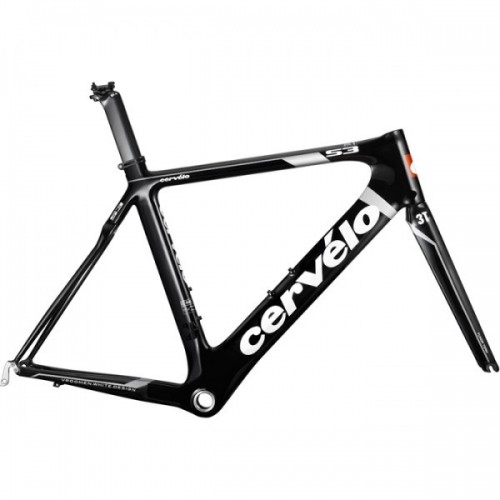
Garmin Cervélo
Cervélo, SRAM, Mavic
The Garmin Transitions team were on Felt bikes last year but now they’ve teamed up with Cervélo as Garmin Cervélo, logically enough, and equally logically they are on Cervélo bikes.
In the recent Tour Down Under, Garmin Cervélo were on S3s which Cervélo describe as “the lightest aero frame in the world”. Cervélo led the trend towards aerodynamic road bikes and the S3 is the top model in the range with a frameset that’ll set you back £3,500. It’s a little heavier than one of their R-Series bikes but significantly better at slipping through the wind thanks to the tube shaping and the frame geometry. We certainly liked the S3 when we reviewed it a while back. The Cervelo test team used other bikes in the Cervélo range and we'd imagine they’ll be picking and choosing from other models as the season progresses with the R5 putting in an appearance in the mountains..
Garmin Cervélo, with a roster that includes Tyler Farrar, David Zabriskie and Thor Hushovd along with Britain’s Dan Lloyd and Roger Hammond, use SRAM Red groupsets while Mavic provide what they call the ‘wheel-tyre’ systems; the French manufacturer is keen to emphasize the ‘tyre’ bit these days.
“After one year of development in common, whether in the wind tunnel or on the road, the athletes and team managers are convinced by the higher Mavic performance level and they support our future projects together,” said Thomas Davy, Mavic’s Sports Marketing Manager. “The racers will use a large part of the 2011 Mavic range: from the Cosmic Carbone Ultimate WTS, the R-Sys SLR WTS, the Cosmic Carbone SLR WTS, and the Ksyriums for the training periods.”
Time trial duties will be taken care of by the Cervélo P4... Well, and the rider too, of course.
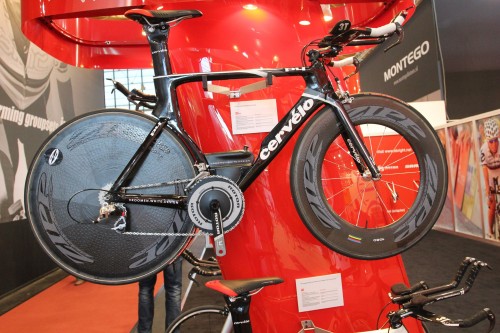
Among the other products used by Garmin Cervélo are Fizik saddles with most of the high performance models being used by one rider or another.
HTC-Highroad
Specialized, Shimano
Yes, they’ve changed their name again, but HTC Columbia (as was) have still got Manx sprinter Mark Cavendish and his chief lead-out man Mark Renshaw on the team, so you can expect them to be letting off fireworks in every bunch finish between now and the end of the season and if it's not them it'll be Matt Goss if the Tour Down Under was anything to go by.
Big changes on the hardware front, though. We’d all got used to seeing Cav on a Scott but it’s new bikes for 2011 with the team swapping to Specialized.
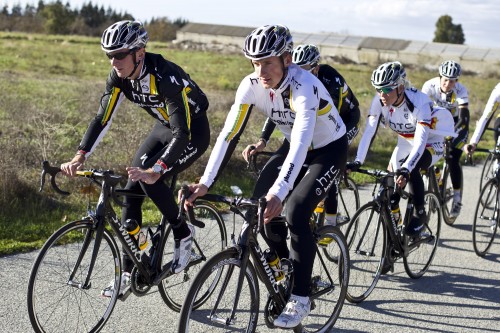
The HTC-Highroad men will ride the S-Works Tarmac SL3 frames and forks for most road races, like Team Saxo Bank Sungard and Astana, and they’ll switch to the Roubaix SL3 for anything cobbly. They’ll race the Shiv in time trials, minus the nose cone that fell foul of the UCI’s equipment rules at the beginning of last year, and they’ll also be using Specialized’s helmets: the new lightweight (185g) and aero Prevail on the open roads, and the TT3 for time trials.
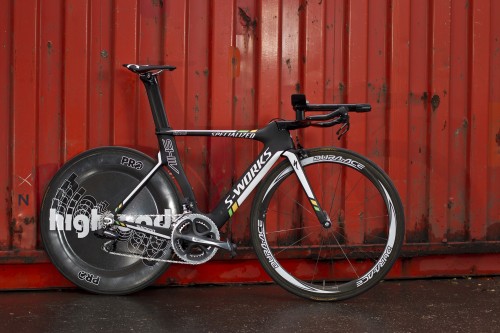
All the team riders underwent Specialized's custom fit service recently and they’re all on stock frames. Well, kind of… most are on racier geometry versions of the bikes with a shorter head tube than standard. 'Team geo', as it was known, used to be an option for average Joes, but no longer because very few amateurs have the same needs or flexibility as the pros.
Much of the componentry comes from Shimano in the shape of Dura-Ace groupset and wheels – C35 clinchers and C50 tubulars, mostly. The bars, stems and seat posts are supplied by Shimano too… kind of. They’re actually from Pro, which is a Shimano sub-brand.
Fizik provide the saddles and, as usual, the riders get to choose their own model from the range – they’ll be spending a whole lot of time sitting on it, after all. Rounding things off, SRM provide the power meters – they absolutely own that sector of the pro peloton with no-one else getting a look in.
Lampre-ISD
Wilier Triestina, Campagnolo, Fulcrum
Italian team Lampre ride Wilier bikes, the Cento1 Superleggera being their usual mount.
For 2011 you can buy the Cento1 in a Superleggera Racing (SLR) format which uses the same tube profiles, materials as the pros’ bikes, and now also the same geometries.
Wilier say, “On the Cento1 Racing, comfort takes a back seat so that we can push performance to the limit. This frame differs from the base model Cento1 in the tube measurements and angles. We have elongated the top tube and shortened the head tube to allow for a more aggressive riding position. The rider can get lower on the bike, which reduces the frontal area's exposure to wind resistance. Cento1 Racing also has a steeper seat tube angle. This positions the rider more forward and improves bike handling and efficiency during hard accelerations. The molds used to lay-up the Cento1 Racing are the very same as those used for team Lampre ISD. It is available in 5 sizes. The frame is finished in matte black, and will be sold for the same retail price as the Cento1 SL.”
That about covers it. Lampre stick with other Italian brands for most of the componentry, going with a Campag groupset, Fulcrum wheels, Vittoria tyres and Selle San Marco saddles.
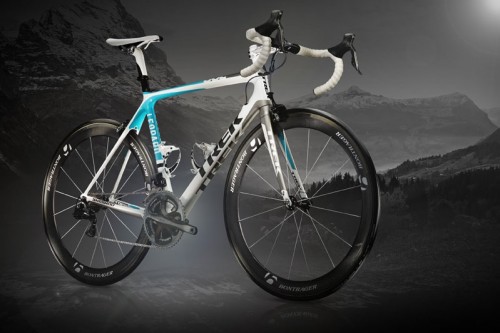
Leopard Trek*
Trek, Shimano, Bontrager
The most talked about team over the off-season has been the new Leopard Trek outfit based around the Schleck brothers and time trial/Classics animal Fabian Cancellara. They’ll be riding on Trek’s top-line Madone, the 6.9 SSL. The Madone has been around for several years now but every summer Trek roll out a new model that’s slightly lighter and slightly stiffer than the last. The current incarnation has a claimed frame weight of just 815g.
The SSL uses OCLV HexSL carbon which Trek reckon is virtually as stiff as high modulus carbon fibre, but over four times stronger with twice the elongation properties.
“Before this material’s culmination we had to use two, sometimes three different layers of carbon to get the same strength and performance that we get from just one layer of OCLV HexSL.” said Trek Road Product Engineer Chris Pomering.
The frame also features a BB90 botttom bracket, E2 tapered head tube (1 1/8in to 1 1/2in) and fully internal cable routing. For more on Leopard Trek's bikes and equipment check out our team launch tech story.
*sorry the caps lock key on my keyboard seems to be playing up
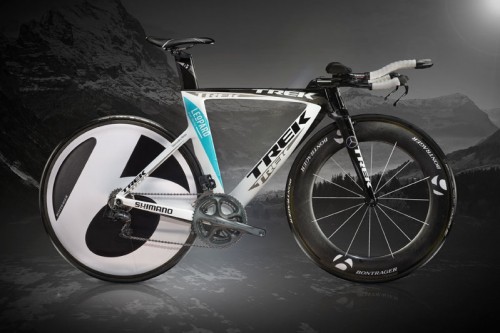
For time trial duties, Leopard Trek will be on board the Trek Speed Concept, which the US manufacturer reckons is the most aero bike ever produced. The technological highlight is Trek’s tube profile which they’ve named the Kammtail Virtual Foil (KVF). Essentially, KVF is a 5:1 airfoil shape with the trailing edge cut off – so, rather than a long, pointed trailing edge, it’s squared back there – improving performance in crosswinds and complying with the UCI’s technical rules.
Most of the components are from Trek’s own Bontrager brand: Aeolus and Race XXX Lite wheels, Race X Lite and carbon Race XXX Lite bars and stems… although Leopard Trek step away from Bonty for their tyres, opting for Schwalbe instead.
The groupset is Shimano’s Dura-Ace with Di2 technology.

Liquigas-Cannondale
Cannondale, SRAM, Mavic
The big equipment change for Italy-based Liquigas-Cannondale this year is a swap from Campagnolo groupsets to SRAM Red. With Alberto Contador using SRAM with Team Saxo Bank-SunGard (if he races, like) and both 2010 Vuelta winner Vincenzo Nibaldi and Giro winner Ivan Basso on the Liquigas-Cannondale squad, the reigning champions of all three Grand Tours will be riding SRAM in 2011.
“We are incredibly excited to work with Liquigas-Cannondale,” said SRAM’s European sponsorship manager, Jason Phillips. “This team is competitive through the entire season, they have incredible leadership in Nibali and Basso, and we expect great things from young superstars Peter Sagan (SVK) and Ted King (USA). The riders are excited about the componentry, how comfortable it is and how quickly it shifts, and the mechanics noted the ease of set-up and the custom features, including reach adjust.”
… well, what else did you expect him to say?
Cannondale has been the technical bike sponsor of the Liquigas team for the past four years and this time around they’ll be supplying SuperSix High-Mod bikes again. They’re full carbon – naturally – with snaking hourglass rear stays, and a tapered (1 1/8in to 1 1/2in) head tube. road.cc recently reviewed the standard modulus version of this frame, and we rated it highly. Cannondale will also be providing their super-light and stiff Hollowgram SL chainsets and bottom brackets in their own BB30 standard,
French wheelmongers Mavic supply the team with their Cosmic, R-Sys and Ksyrium models while FSA chip in with the bars, stem and K-Force Carbon seatpost. The saddles come from Fizik and the pedals are Speedplays.
Omega Pharma Lotto
Canyon, Campagnolo, Mavic
Hailing from Belgium, Omega Pharma Lotto is the home of Jurgen van den Broeck, Classics specialist Philippe Gilbert and newly signed German sprinter André Griepel.
The main bikes they ride are the Canyon Ultimate CF SLX and the Aeroad CF. The Ultimate CF SLX comes with a double-walled hollow bottom bracket shell for added stiffness, a Maximus seat tube that bulges out on the non-driveside for more rigidity, and skinny VCLS stays that are designed to offer some flex out back.
The Aeroad CF, as the name suggests, is designed with aerodynamics in mind. Canyon say, “The cockpit is positioned lower which reduces drag, the frontal area of the frame is 20% smaller than that of the Ultimate CF SLX and has aerodynamically optimised tubes. You'll appreciate that above all in breakaway groups.”
For time trialling, riders move to the Speedmax CF with aero-shaped tubes and seat post, internally routed cables, and a Canyon Carbon Aero fork.
Omega Pharma Lotto run Campag groupsets and a whole range of wheels from Mavic, and they’re one of the few teams on the WorldTour to use Ritchey WCS cockpit components.
Quickstep
Eddy Merckx. Campagnolo
Belgian team Quickstep, including Tom Boonen, are on Eddy Merckx bikes again in 2011, but unlike last year it’s the new EMX-7 that the riders will want to be on.
The EMX-7 comes with a fast-becoming-standard tapered head tube (1 1/8in to 1 1/2in), integrated seatpost, pressfit bottom bracket and internal cable routing. The tubes are airfoil shaped, the fork crown blends into the down tube, and the chainstays are asymmetric with extra beef on the driveside. The team will also use the EMX-5, although it’s upgraded over last year’s design.
Quickstep is one of just a few WorldTour teams that use Campagnolo components. Interestingly, they go for Record rather than the top tier SuperRecord. Campag supply the wheels too: Bora Ultras mainly, although Zondas were on display at the Tour Down Under too, all with Vittoria tyres. FSA provide handlebars and stems, the saddles are Prologos, and the pedals come from Look.
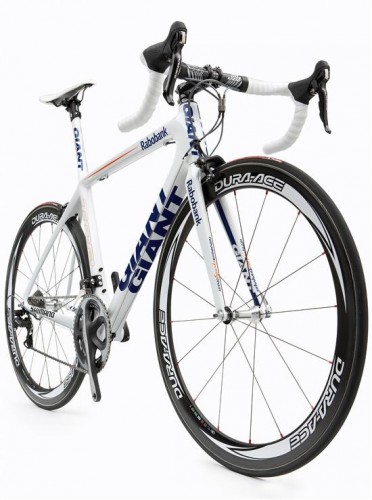
Rabobank
Giant, Shimano
The main man on the Dutch Lampre team is Spaniard Oscar Freire, although new recruit Michael Matthews recently chipped in with a stage win in the Tour Down Under and fourth place overall.
The team does most of its racing on board Giant TCR Advanced SLs. Giant’s spiel goes like this: “With its winning combination of stiffness, lightweight, compliance and sharp handling, the TCR Advanced is often imitated, never duplicated. Featuring the highest performance Advanced SL-grade composite, hand crafted construction and race winning compact geometry with an integrated seatpost and massive MegaDrive downtube, TCR Advanced SL is the hors categorie performer.”
It’s built to Giant’s usual compact geometry. We guess you know the reasoning by now: small frame triangles equal less weight and less flex – although, it must be said, that’s offset to a degree by a longer than normal seatpost. In this case, that seatpost is of the integrated variety.
Shimano provide the groupsets and the wheels, including C50s and deep-section C75s, the saddles are from Fizik and the Vittoria bring the tyres.

Last year Rabobank time trialled on the Giant Trinity Advanced SL and we assume it’ll be the same this time around, or a variant.
Team Katusha
Focus, SRAM, Vision
Russia’s Team Katusha have several riders capable of making an impact in 2011, including Filippo Pozzota, Joaquin Rodriguez, and a returning Danielo Di Luca.
They ride Focus Izalco road bikes built with a slightly sloping top tube, BB30 bottom bracket and internal cable routing – the rear mech cable is now routed through the chainstay rather than exiting at the bottom bracket. The tapered head tube houses a 3T Rigida Pro fork while SRAM provide the groupsets.
The Katusha riders will be aboard the Focus Izalco Chrono, which comes with deep-section tubing and a seat tube that hugs the leading edge of the rear wheel.
Bars, stems and seatposts come from FSA, who are incredibly dominant in this area among the pro teams, and the wheels are from Vision, which is part of FSA: 50mm deep TriMax Carbons and 88mm TriMax Ultimates.
The riders roll on Conti tyres and pick their saddles from the Prologo range.
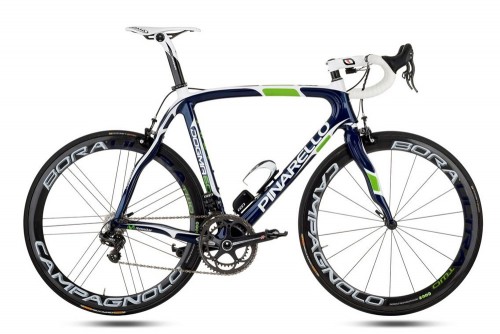
Team Movistar
Pinarello, Campagnolo
Spain’s Team Movistar used to go by the name Caisse d’Epargne (and Banesto way, way back), and most of the riders are Spanish. They lack big name riders although time trial specialist Ivan Gutiérrez is part of the squad.
Like Team Sky, Movistar are on Pinarello Dogma 60.1s (see above), making Pinarello one of only three bike brands with more than one WorldTour team in 2011 (the others being US giants Specialized and Trek).
Movistar are unique, though, in using Campagnolo’s electronic shifting system. They’ll be trialling prototype equipment throughout the season prior to it being released onto the market, and have already given it a run out at the Tour Down Under. Details are still hazy but it looks like the Campy Tech Lab system is broadly similar to Shimano’s Di2 in that it uses wires instead of cables and a battery mounted on the down tube. But unlike Shimano’s 10-speed system, this one goes up to 11.
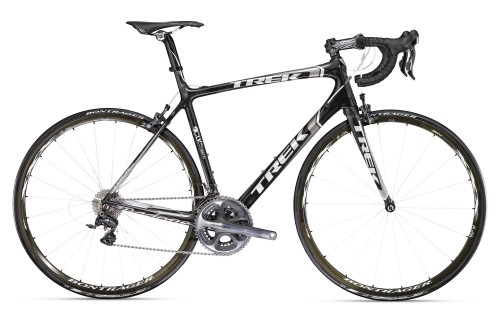 Team Radioshack
Team Radioshack
Trek, SRAM, Bontrager
Lance Armstrong has been Trek through and through for years so it was inevitable that Team Radioshack would be on board Madones when the Texan led the team in their first year’s competition in 2010. The association continues in 2011, the US-based team riding the same Madone 6.9 SSL frames and forks as Leopard Trek.
Radioshack’s bikes are decked out in Bontrager components too, like those of the new Luxembourg outfit. They use Bonty Aelous and Race XXX Lite wheels – although there are apparently some new wheels being trialled right now – Race Lite and Race XXX Lite carbon VR bars, and Race XXX Lite carbon stems.
One major difference, though, is that whereas Leopard Trek use Shimano groupsets, Radioshack are sticking with SRAM Red with DoubleTap shifting – US team, US components.
Like most of the pro teams, Radioshack rely on SRM for their power feedback. The German technology is still regarded as the gold standard in the peloton.
Look provide the pedals. Last year the Radioshack guys were nearly all using the top end Kéo Blades and we think it’ll be the same this time around.

Team Saxo Bank Sungard
Specialized, SRAM, Zipp
A whole bunch of Saxo Bank’s riders jumped ship over the off-season, including the Schleck Bros Inc and Fabian Cancellara, while incomers include a certain Alberto Contador… so we’ll see how that one turns out for them.
Bjarne Riis is still the head honch, though, and Specialized are still providing the bikes. The S-Works Tarmac SL3 will be the default mount. It’s extremely light with a full carbon bottom bracket shell, for example, without the need for metal cups, and incredible torsional stiffness. Like many of the other manufacturers, Specialized use a 1 1/2in lower headset bearing that allows them to beef up the fork steerer and head tube for extra front-end rigidity.
The riders will swap to the Roubaix SL3 for the cobbled classics. The 2011 incarnation gets the In-Zertz viscoelastic dampers used on previous models bolted into carbon cavities in the seatstays and fork legs – so, essentially, there’s a little pocket of cushioning to reduce road vibration. There’s another Zertz insert in the seatpost which, being a slim 27.2mm in diameter, helps take the sting out of rough roads.
Specialized also engineer a degree of flex into the frame through the type of carbon fibre they use and the fact that the tubes are flattened. And the Roubaix’s geometry is a little less stretched than a standard road race design, and a little higher up front to give a more relaxed ride position.
Saxo Bank go with SRAM Red groupset components and a wide range of Zipp wheels picked according to the terrain and the conditions. FSA provide K-Force bars and seatposts, the pedals are from Speedplay and Prologo supply the saddles.

Team Sky
Pinarello, Shimano
Britain’s own Team Sky, which includes Bradley Wiggins, Ben Swift and Geraint Thomas, will be on Pinarello again for their second season of road racing, using the Dogma 60.1. Pinarello describe it as “the first completely asymmetric racing frame” – differently shaped on the drive and non-drivesides to take account of the different forces.
The driveside seatstay, for example, is built thicker to resist the extra stresses of the chain and cassette, while the front end of the left-hand chainstay is reinforced because it’s more vulnerable to damage than the right one (which is protected by the chainset).
Team Sky is another squad using Shimano Dura-Ace Di2 electronic shifting, the battery sitting just below the down tube bottle cage, and the wheels are DA too. You’ll often see team members using SRM power meters as well. Deda provide the bars and stems and the saddles are from Prologo – most of the team opt for the Scratch Pro TR.
Pinarello’s Graal is the Team Sky weapon of choice for time trialling, coming with a steep seat angle, a vertical seatpost, a front brake that’s hidden behind the fork, and the Di2 battery integrated into the chainstay. The Anura bar is designed specifically for the frame and features internal cabling to improve the aerodynamics.
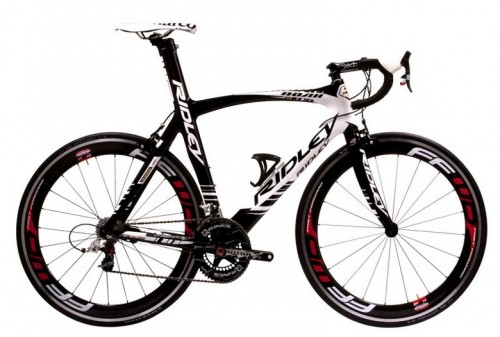
Vacansoleil-DCM
Ridley, SRAM, FFWD
If you’re wondering “who the hell are Vacansoleil-DCM?” well, pay attention for goodness sake; they finished as the top team in last year’s Tour of Britain, although this is the first year that the Dutch squad have been in the top tier of international racing. As for personnel, the best-known name on the team sheet is Riccardo Riccò. Yeah, him who did that amazing climbing in the 2008 Tour and then got busted.
Anyway, this year they’re on Ridleys with Noahs and Heliums at their disposal. The Noah is Ridley’s aero road bike which boasts their R-Flow technology: “Slotted razor-sharp airfoils on the fork blades and seat stays, [that] redirect the airflow away from the turbulence of the rotating wheels and in fact, create a vacuum that further defeats aerodynamic drag,” according to Ridley.
The Noah also has R:Surface paint technology – a rough surface on leading edges that’s designed to further reduce drag – along with internally routed cables and an integrated post rather than a standard seat tube/ seatpost combo.
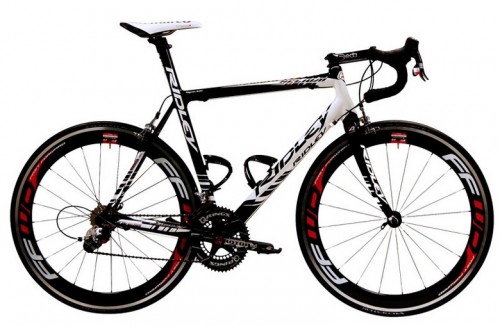
The Helium has an integrated seatpost too but it’s considerably lighter – just 950g to the Noah’s 1,075g, according to Ridley’s own figures. It has round tubes and a degree of flex engineered into the seatstays for a more forgiving ride. Expect to see it on mountain stages when weight is key, and over the pavé where comfort is important.
Dutch brand FFWD (Fast Forward) provide the wheels. They do a whole range but the 60mm deep F6 seemed to be the one the riders were going for at the Tour Down Under. The groupsets are SRAM with Rotor chainsets, the cockpit components are Deda, the saddles are San Marco and the pedals are Looks.
Mat has been in cycling media since 1996, on titles including BikeRadar, Total Bike, Total Mountain Bike, What Mountain Bike and Mountain Biking UK, and he has been editor of 220 Triathlon and Cycling Plus. Mat has been road.cc technical editor for over a decade, testing bikes, fettling the latest kit, and trying out the most up-to-the-minute clothing. He has won his category in Ironman UK 70.3 and finished on the podium in both marathons he has run. Mat is a Cambridge graduate who did a post-grad in magazine journalism, and he is a winner of the Cycling Media Award for Specialist Online Writer. Now over 50, he's riding road and gravel bikes most days for fun and fitness rather than training for competitions.
Latest Comments
- chrisonabike 1 min 28 sec ago
Given that the usual formula for road damage is proportional to axle weight to the fourth power - they do a lot more damage per person....
- wtjs 1 min 53 sec ago
in the UK we have policing which to a greater or lesser extent relies on assistance from members of the public......
- hawkinspeter 36 min 57 sec ago
You need to try a different shop - my Bonts were sold as a pair
- levestane 38 min 19 sec ago
This is tech doing it's job, extracting money from punters.
- imajez 40 min 24 sec ago
I never pay attention to Facebook suggestions/ads, but the very beautiful and clever split frame design in a Feather Cyles post caught my eye. It...
- SecretSam 1 hour 19 min ago
Maybe take some drugs to calm your nerves...
- SecretSam 1 hour 20 min ago
So...don't cycle on it. Lots of other routes around that area. Source: I used to work there.
- Hirsute 1 hour 24 min ago
Armando Iannucci "Today is Day One of humanity’s Idiolithic Era."
- Steve K 1 hour 39 min ago
My photochromic specs have just turned up in the post today
- Paul J 1 hour 46 min ago
Downhill Alpe d'Huez TT would be _awesome_. And someone should organise one for real!...
























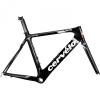
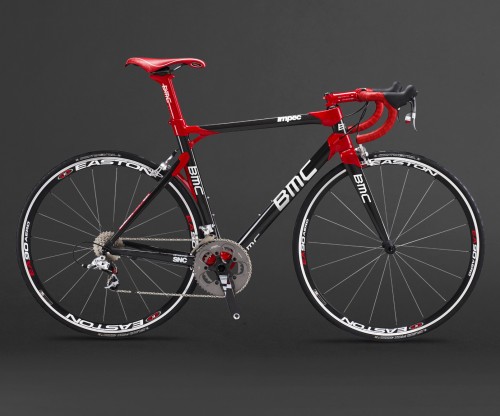
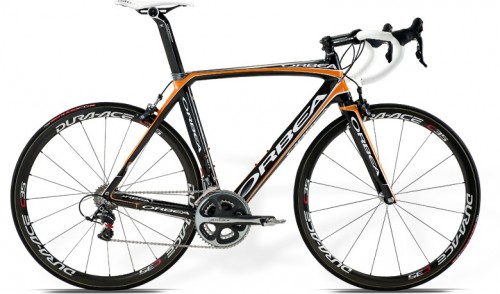
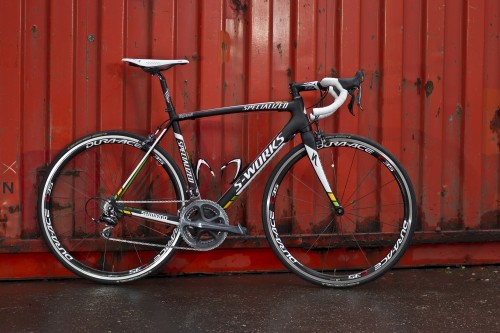


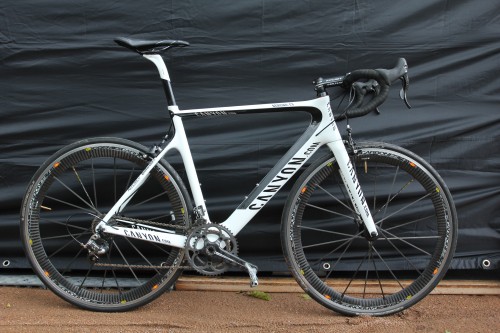

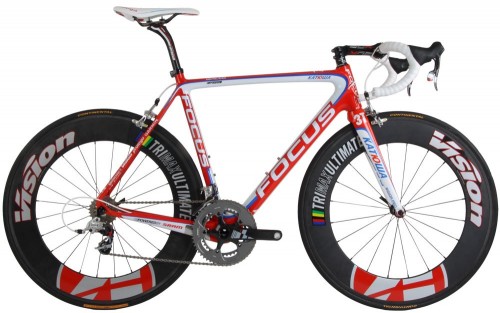
Add new comment
10 comments
I think that could have something to do with the amount SRAM are spending on sponsorship and the deals they will do on price for those teams they don't sponsor
strange how so many teams are opting for SRAM when it-unlike shimano& campangalo- does not have electric parts
The continuing demise of Campagnolo in the pro peloton is alarming. Forza Vincenza!
Yeah I liked the Felt, but don't think the Focus is that ugly - well if you swapped the deep section wheels off. The Euskaltel Orbea is still a looker though… not sure there at that many really pretty bikes in the peloton this year though. Oh, and does anyone else think the Quickstep Merckx has a touch of the Mercians about it around the seat tube?
wow that Katusha offering is a trainwreck.
Also, shame felt have no home this year - wonder if that will change next.
SRAM - my chain keeps coming off though.
Me too Jimmy!
me!
Shock - Liquigas switching to SRAM.
Who is using Campagnolo this season?
Quickstep on Merckx frames.
Omega Pharma Lotto on Canyon frames.
BBOX BOUYGUES TELECOM on Colnago frames
COLNAGO CSF INOX